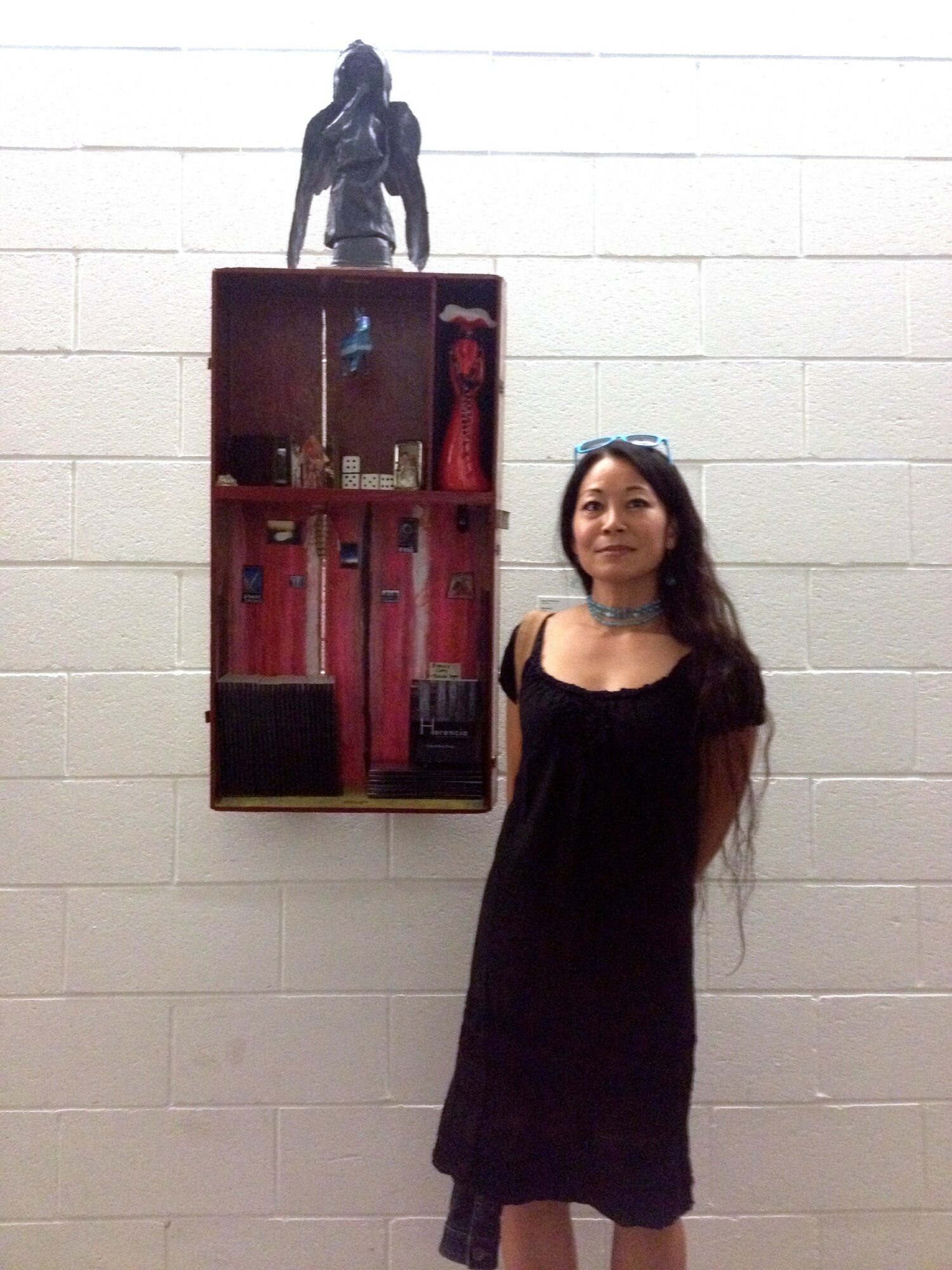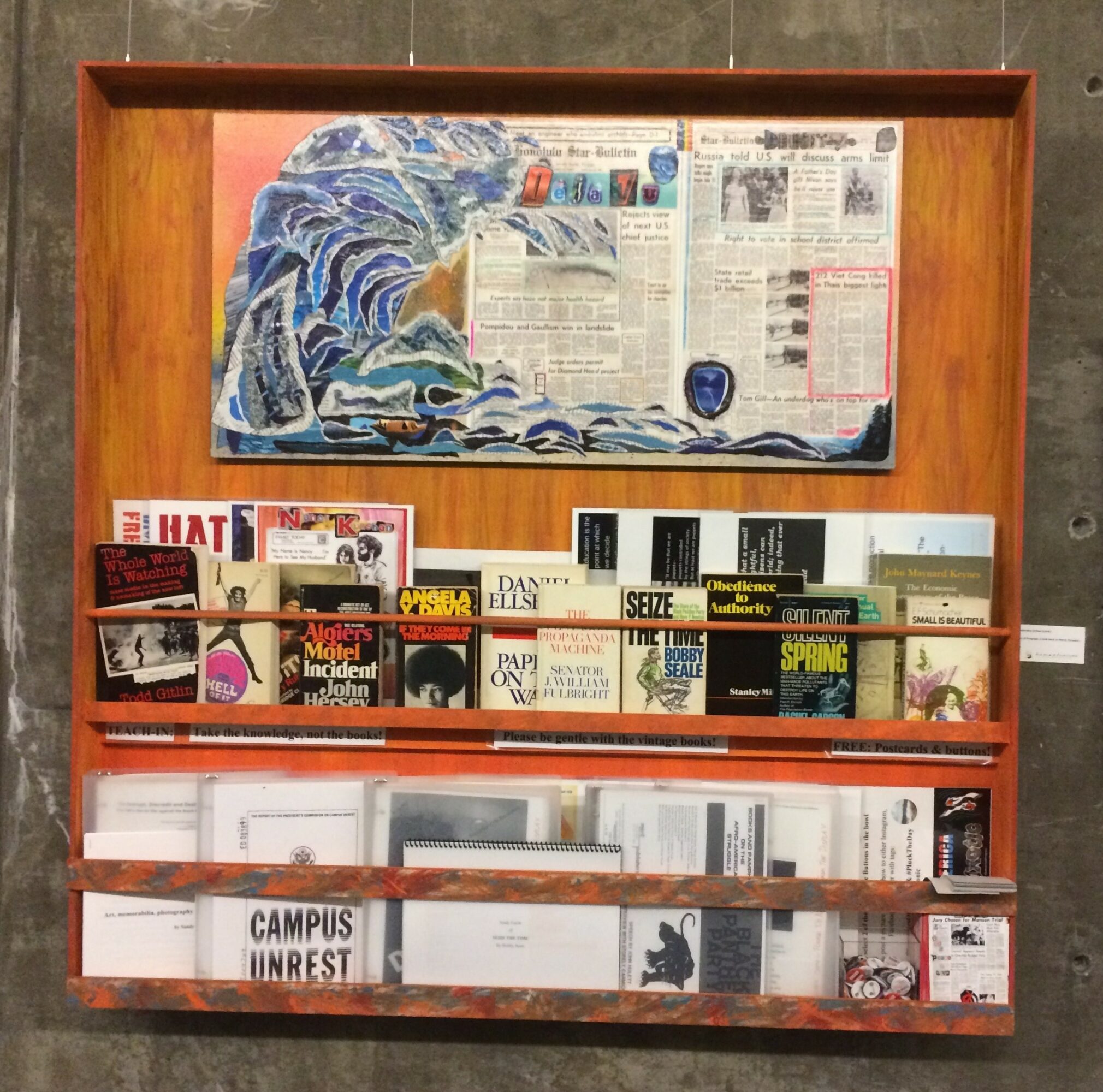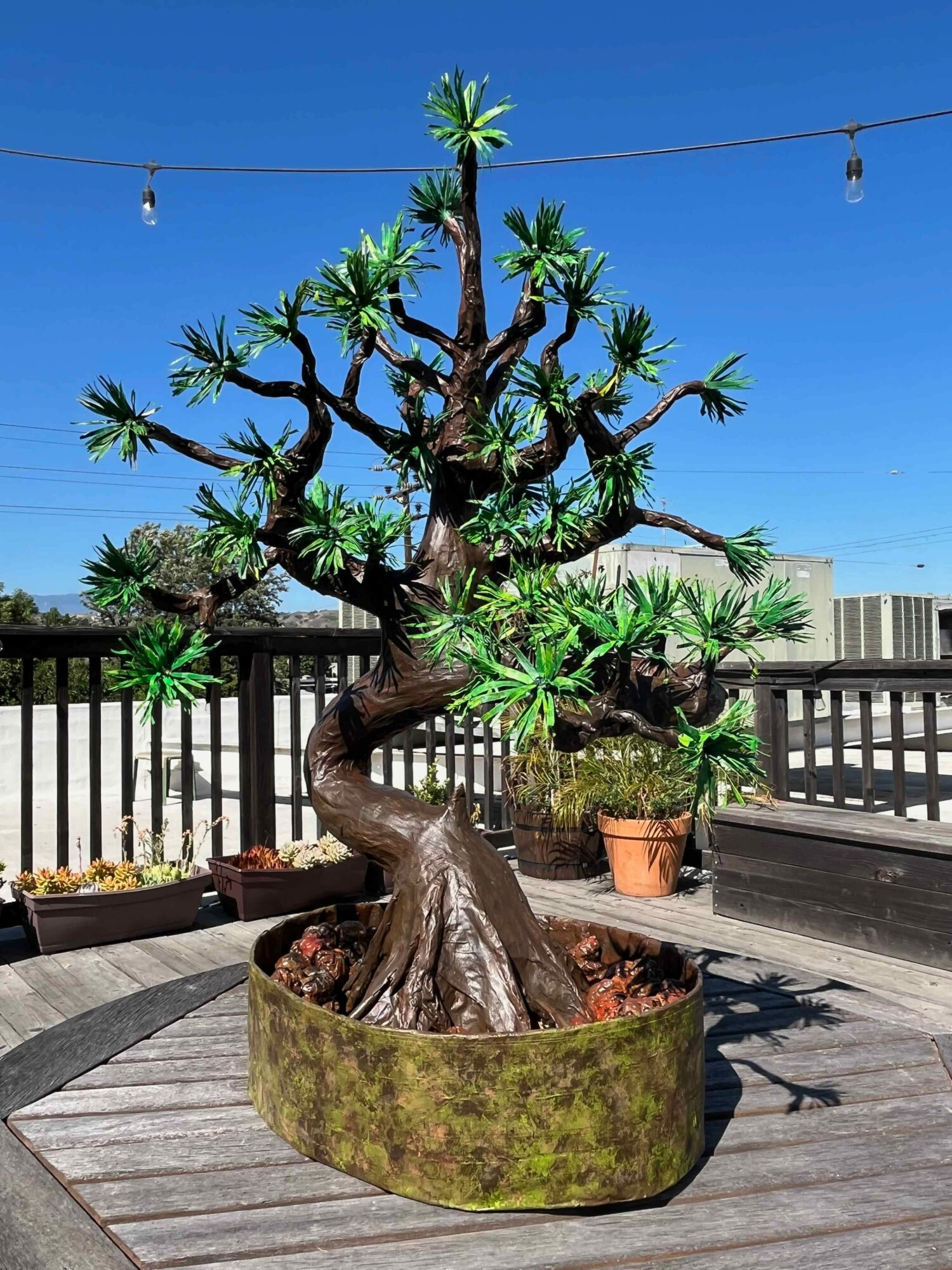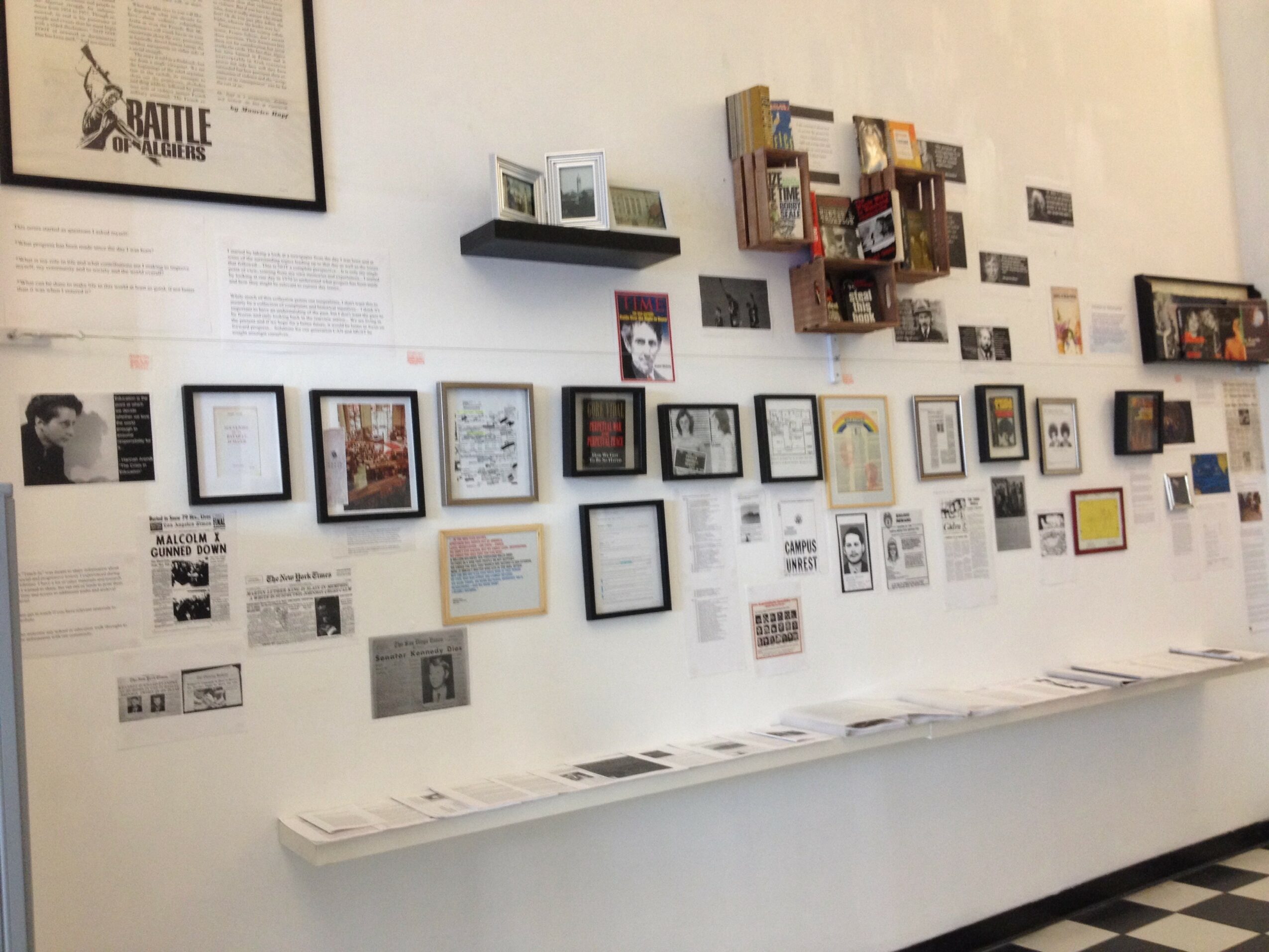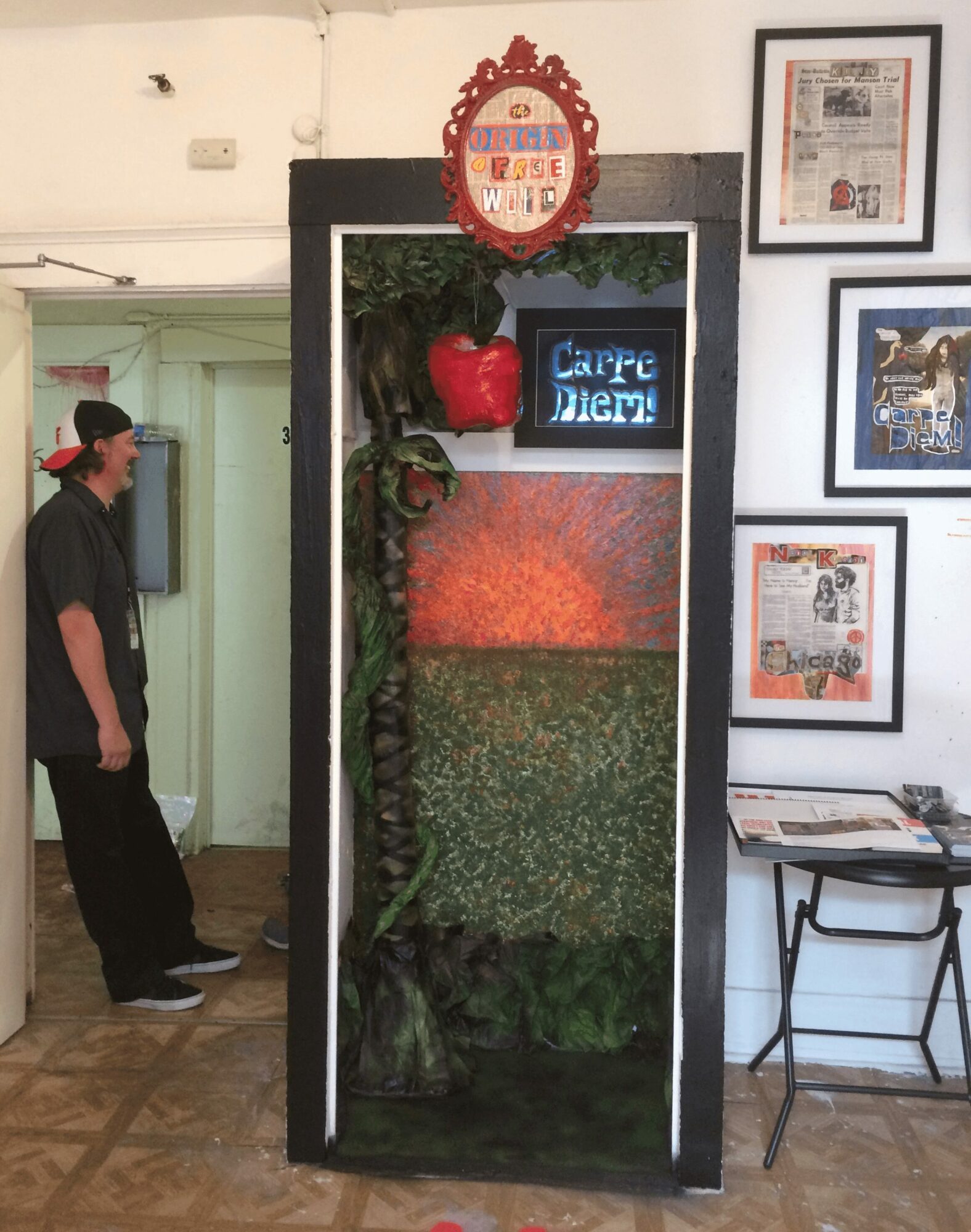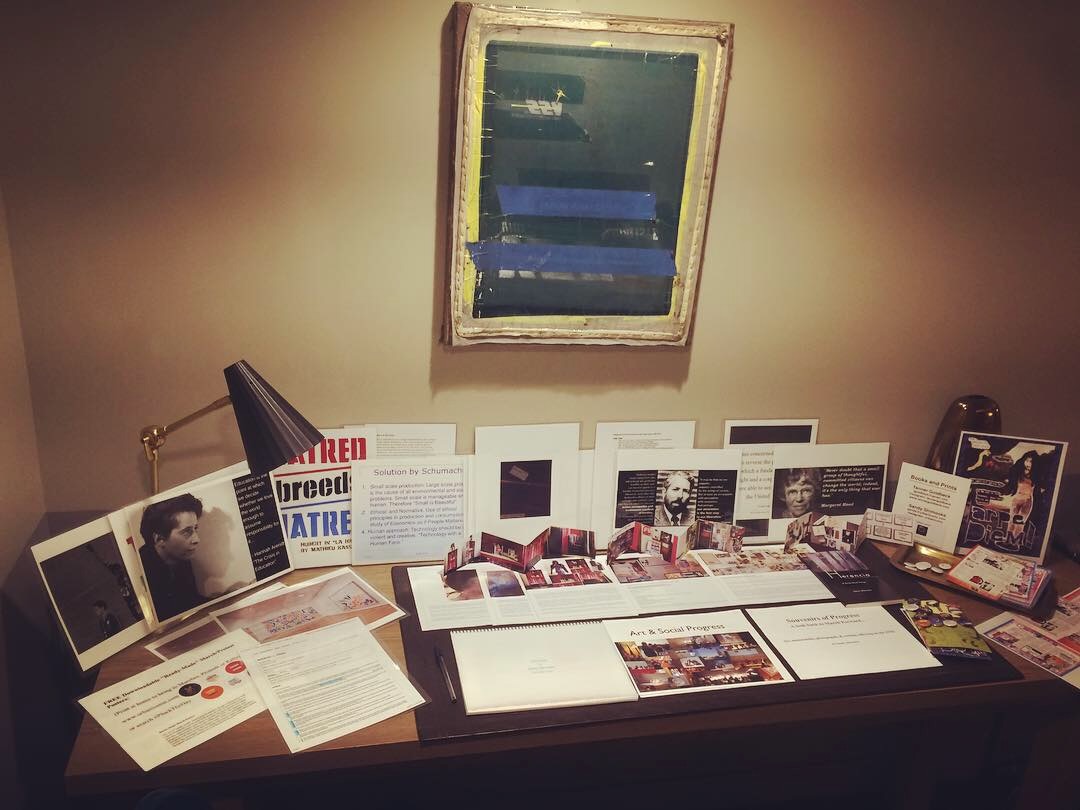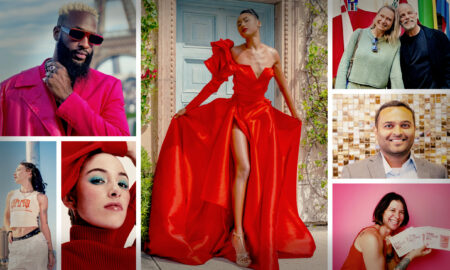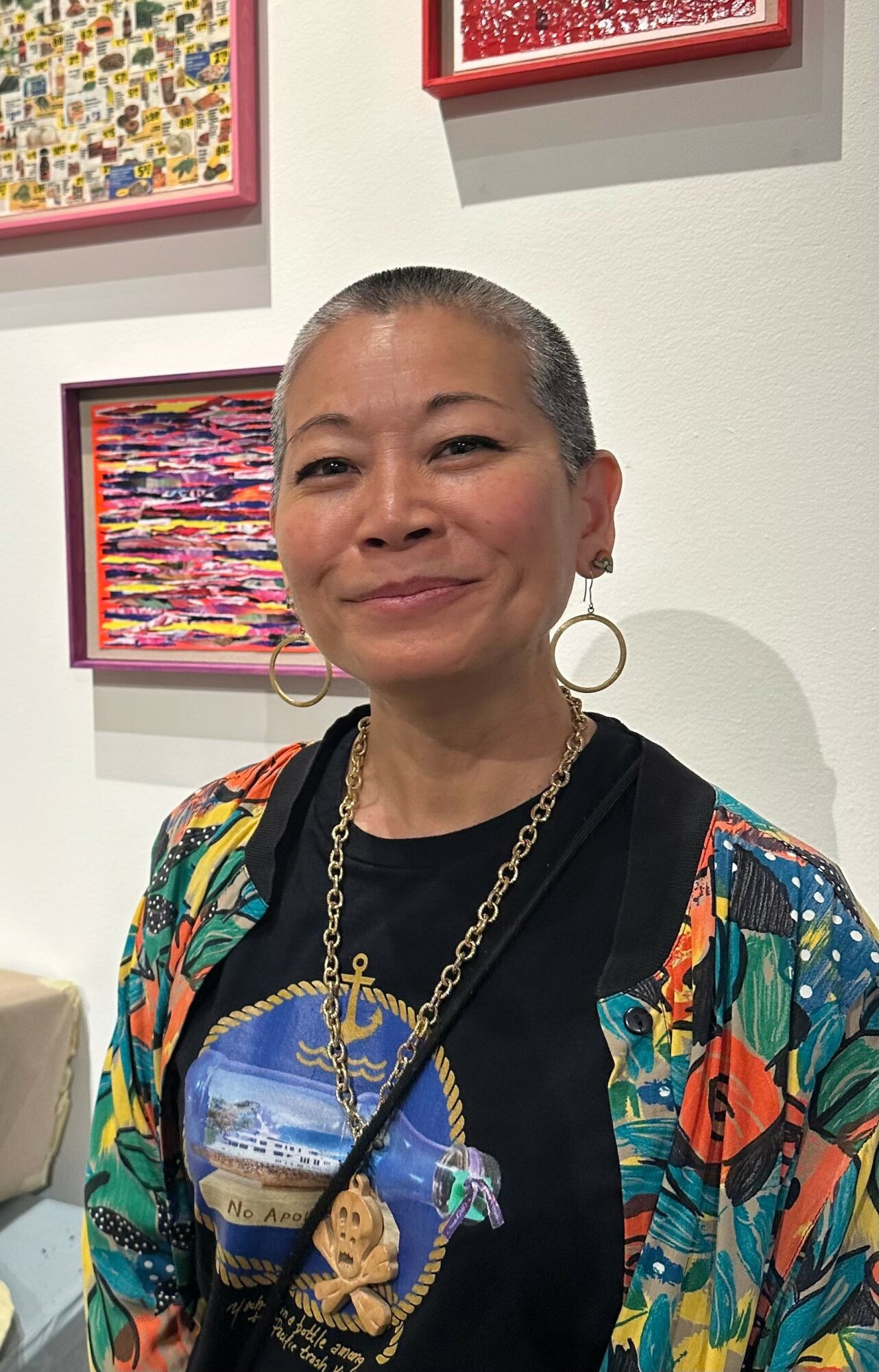

Today we’d like to introduce you to Sandy Shimooka.
Alright, so thank you so much for sharing your story and insight with our readers. To kick things off, can you tell us a bit about how you got started?
I appreciate this Voyage LA interview and it is giving me a moment to think about things and remember a lot of people and places that are part of my journey.
I currently live in The Brewery Art Complex in Lincoln Heights, but I have lived in other parts of Los Angeles, including Santa Monica, Venice and the Valley. My partner, Tanner Goldbeck, is also an artist. We lived together in Downtown Los Angeles for over ten years. I also spent time in Europe intermittently for about seven and a half years, as well as Hawaii, San Diego and the Bay Area.
I think one of the strengths of LA is its vast and diverse neighborhoods and populations. Rather than consider it to be a competition between groups and regions, I think we should embrace all of it, support each other and consider our multiplicity to be a strength.
Despite lots of moving and traveling, Los Angeles has been home base, especially for my father and his side of the family. Much of my family’s history reflects a bit of what is going on right now in politics, and the world, and you can see a lot of these existential stories and themes reflected in my art.
First of all, I cannot think of my life without considering all that my mother contributed and sacrificed in order for me to be here. My mother is also the reason why my father was able to start his businesses. It was my mother’s savings and the marriage money from my mother’s mother that my father used to start his first business. Until my second brother was born, my mother worked (even while pregnant three times) to support all of us because my father’s first business never made money. While many of the men in the family were given accolades for various accomplishments, it’s what my mother and grandmothers did in the background that financed and enabled these things.
My mother originally worked as an accountant in Tokyo, but since her father abruptly passed away when she was twelve, and she did not have options to marry within her class in Japan, she followed her older sister to Hawaii where she ended up studying English and working at a hair salon. It wasn’t until her fourth child was born that my father finally agreed to allow her to become an American citizen. Like many people that immigrate, my mother ended up trading most of her life ambitions in order to adapt to her new status as a foreigner. Like many women, she forfeited her own aspirations to take care of her family. A lot of my life and work has my mother in mind. While I usually don’t reference her directly, I decided that the best way for me to honor my mother is by living my own life as best as I can, so that all of her sacrifices were not done in vain.
Five of the six children in my mother’s family got cancer, possible from environmental issues, such as DDT and other sprays being used where they grew up, and they had a photo lab in their house, so they might have spent too much time being exposed to those chemicals, as well as possible water, food or environmental contamination from the atomic bombs dropped during World War II. My interest in the work and writing of scientists and environmentalists like Rachel Carson is a direct result of that. History, reflecting on the past and relating them to current day issues, is another theme throughout my work. While I think that technology and progress are always propelling things forward, and time makes each moment and generation unique, the underlying themes of life and the human condition link all stories together.
Some of the strangest coincidences in life are both a curse and a blessing. I was originally born in Hawaii. My mother was from Sakata, Japan and my father was from Los Angeles. We moved to San Diego when I was five, after a near fatal car accident gave my parents a payout that enabled them to pay off debts, move back to California and buy their first home. My parents didn’t stay together and there are a lot of complicated interwoven stories that also make me who I am, but after university in the Bay Area, I moved to Los Angeles, initially to work in the film industry. I had also been doing things on the side with friends that later developed into online startups, gaming and the foundation of the tech industry today. That lead me into a variety of projects that allowed me to move to Europe for a couple of time periods. I had hoped to find paths for my film and photography interests, but I ended up spending most of my time doing research, strategy and creative consulting work. However, living abroad and traveling allowed me to cultivate my side interests in art, art history and culture, so I was able to use the work travel and mileage to fund my hobbies.
I used to really enjoy taking photos and being in the dark room, but as I felt more sensitivity to the chemicals, and as photography became more digital, I started doing less photography. I didn’t find as much satisfaction working on my computer as I did making things by hand. I also enjoyed expressing things in ways that weren’t necessarily “realistic” and had more textural and pattern aspects to them. Collage, writing, sketching and some other hobbies were originally part of my travel documentation and personal journalling, but they began to be more important to me in terms of the making and creation process. I also collected ephemera, books and other miscellaneous stuff that I use in my art. Subconsciously, I am also affected by some of the things my mother had when I was a child. They were made of cut and folded paper, including origami and kirigami images. I also love learning about the intersections of civilization, human history and the evolution of the universe and nature. I’m fascinated with the constant drivers of technology and progress against the human condition. How some things radically change through time, and yet other things stay consistent for all living things.
I lived on the Westside during the 90s and my father and his family also have history there. Places like Sawtelle Aveneue, Santa Monica beach and Hastings Plastics have meaning that span both my father’s history and mine. Hastings Plastics not only supplied things like resin, epoxy and polyurethane that enabled the surf and skate industry for my friends, but it also provided experimental materials to artists like Billy Al Bengston, Larry Bell, DeWain Valentine, Helen Pashigan, Ed Moses and other contemporary artists. My father used those same materials from Hastings for design products he made in his first business, Lanicraft. My father also used to workout on the rings at Santa Monica beach, a place that had been known as “The Inkwell” and it’s part of the same area, near Bay and Bicknell, where my friends and I would hang out.
Some of my story originates from surf, skate and a wander culture. While I spent time studying art, art history, film and lots of other things in university, those friends I spent time with daily and multi-daily, especially on weekends, during the 90s, were really important to me. There were a couple of groups of friends, mainly two separate groups, but they were such a big part of my life outside of work. We spent time doing some random things, everything from snorkeling, fishing and skating in parking structures at night, to sketching, making clothes, stickers, flyers, surf and skate equipment, and other things we needed. Everyone in the group had their own side skills that contributed to us keeping ourselves entertained. We did road trips, camping, international traveling and went to concerts and raves. It was an inspirational mashup of surf, skate, moto, BMX, music, fashion, film, photography and other DIY things. It wasn’t anything you would learn in school, but it was a go-with-the-flow life, of constant improvisation and experimentation. We were figuring out how to create our own unique stuff, making things that could not be bought. We were mostly broke, but had a really good time figuring out how to go to as many places and do as many things as we could. It was a great time of being young, experimenting, developing our own style, personalities and interests, and wanting to explore the world. There was a huge sense of freedom and optimism in the 90s. The Berlin Wall had just come down, Apartheid had ended in South Africa and it seemed like the Cold War was over. Air travel was cheap, and so was gas and rent. There were some sketchy moments too, but mostly lots of priceless memories and experiences with some amazing people. It has left a permanent visual and audio impression on all that I do. I get a rush of adrenaline just thinking about some of those times.
My great grandparents on my father’s side originally came here to be prospectors, and to escape the high taxes and civil unrest in Japan. By the time they arrived, the Gold Rush was over, so they ended up doing migrant farm work and they settled down in Semi Valley in the early 1900s. After dropping out of high school and running away from home to work as a fisherman in Mexico, my grandfather returned and bought his first property in the San Fernando Valley, during the 1930s. My father and his older siblings were born there and they lived there until being forced to leave for Manzanar.
My father’s mother was born in Hawaii, to a family that owned dry cleaning businesses, but after the untimely death of her father, her mother needed money and sold her to my grandfather and his family. The laws at the time did not permit interracial marriage, so my grandmother having been born in America, and speaking both English and Japanese, made her valuable. When my grandfather bought his first property and wanted to get married and start a family, there weren’t many choices for Japanese or Japanese American women, so his family approached my grandmother’s family. Initially, my great grandmother refused, but my grandfather’s family offered money for the arrangement. Since she was newly widowed, with five children, my grandmother being the oldest daughter, her mother gave in and accepted the money in exchange for my grandmother, who was only fourteen or fifteen at the time. My grandmother made the best of things, and it’s an example of what I mentioned was a mixed blessing of life coincidences. While it was horrible being sold by your own mother, then being incarcerated in Manzanar during World War II, it probably saved my grandmother’s life because the rest of her family had to return to Hiroshima after her father passed, so there was a good chance that my grandmother would have perished in the bomb if she had not been forced to marry my grandfather.
I remember my grandmother knowing how to make everything from scratch from ketchup to soy sauce. It came from the tough times she endured, especially during the Great Depression, when my grandparents couldn’t even afford rice and had to cook flour into a paste to eat. My grandparents worked really hard, seven days a week, saving all they had to build their house, start their farm and buy their first car. All of that came to an end with President Roosevelt’s Executive Order 9066, which made anyone of Japanese ancestry, including infants in orphanages, go to the incarceration camps. My father was four at the time and after being housed in horse stalls at Santa Anita Race Track, he and his family were forced to live in Manzanar. After the war, they were relocated to the Sawtelle neighborhood of Santa Monica.
Santa Monica always had special memories for my father and his family. When they were first released from Manzanar, after almost four years in the desert near Death Valley, the relocation bus drove to the end of the 10 Freeway and they saw the bright blue water and white sand of Santa Monica beach. My father became a gymnast in high school and that is partially due to some of his memories of seeing people exercise and workout on Santa Monica beach and the rings. When my father’s family finally saved up enough money to buy another home, they relocated to North Hollywood. The redlining laws at that time prevented them from buying property on most of the Westside. Racial integration and school bussing was also happening then, so my father ended up going to North Hollywood High. He was drafted immediately after he graduated, and he served in the army’s “Screaming Eagles” Airborne Division. His service time enabled him to get a job working for Lockheed while studying at night through the GI bill. He moved back to Santa Monica in the 1960s, where he lived near Stewart and Pico. It was then that he came across Hastings Plastics in Santa Monica and that inspired him to later start his first business, Lanicraft, a furniture, lighting and interior accessories company that featured objects designed from new materials technology: plexiglass, resin and epoxy. These new materials featured by Hastings Plastics was important for many of the artists as well as surfers and skaters on the Westside. They provided knowledge and new materials that sparked developments in contemporary art, extreme sports and technology projects.
Both of my grandparents were multi-lingual, speaking both English and Japanese, and my grandfather even spoke Spanish. He dropped out of high school in his teens and ran away to Mexico where he worked as a fisherman for a few years before returning to buy the property in San Fernando Valley. After World War II, speaking Spanish came in handy because he became a fishmonger, buying fresh fish and produce in Downtown Los Angeles and selling it in the Valley. My grandmother’s younger brother spoke seven languages, having worked for a Japanese import-export company. However, because of the experiences of racial discrimination during and after World War II, my father and his family insisted that my brothers and I be brought up “fully American” and not learn how to speak Japanese or adopt any Japanese mannerisms. My mother was pressured to give up speaking her language, cooking food she grew up with, and dressing and behaving in Americanized ways so that her background didn’t affect my brothers and I. It makes me sad that it was from the racism and prejudice my father and his family faced around World War II. It makes me worried to see these issues against immigrants and minorities resurface, especially after all of the sacrifices and decisions that were made in my parents and grandparents generations to fully integrate and assimilate into America.
I am amazed that during the time span of my father’s generation, he witnessed desegregation, school integration, interracial marriage, the end of redlining, the end of forced military draft and many other things that seem to be taken for granted today. By the generation of my brothers and I, we grew up believing that being American meant being part of a country that respected various customs, religions and practices that contribute to its multicultural heritage. I thought we were united in our belief to respect differences and use our country’s diversity as a strength. Some of the things being said and done to divide us now go directly against all that I was raised to believe about our country.
Can you talk to us a bit about the challenges and lessons you’ve learned along the way. Looking back would you say it’s been easy or smooth in retrospect?
As with all of life, nothing has been easy or smooth, but I also think that much of what makes me who I am, and has made my life interesting, are the challenges and struggles. Obstacles instigate pause, introspection and learning. There are so many things in my life that did not go as planned, but ended up helping me on my journey to find myself now, including multiple startups that I worked for in the early tech industry going bankrupt in the 90s and early 2000s. While those were financially challenging times, not being paid wages for months, then losing those wages and company stock when those companies went bankrupt, I am glad I was part of the early tech industry. I learned those lessons and am also glad it forced to not stay on career paths that I wasn’t happy doing. Originally I thought that it was a way to fund my “hobbies” and I did those jobs to have a steady income, but it drained me so much that I wasn’t able to pursue my true interests. I learned a lot of things that have been valuable though, so I’m glad that I was a part of it for a time, but was ultimately forced to change course.
Another early lesson in challenges being a good thing, was right before high school. I remember telling my father that I wanted to go to UC Berkeley. He laughed and told me that first of all, only hippies, druggies and left wing radicals went there and second, I wasn’t smart enough. To be fair, I wasn’t showing any particular potential as a middle school student, and had no idea what going to UC Berkeley would require, but him saying those things made me determined to spend all of high school working very hard to prove him wrong.
My mother having cancer was another really challenging time. Nothing I did, no matter how hard I tried, could change the outcome. It was difficult to see my mother suffer at the end, especially knowing all that she sacrificed for my father, brothers and I to be here and have our lives. My father had remarried and moved on without repaying or providing anything in return for all that my mother had sacrificed for him. It felt really unfair, but my mother also handled dying as gracefully as anyone I’ve ever known. She taught me to appreciate life, that life might not be fair, but how to face even the most difficult moments without fear, and not take time, or anything else for granted.
Can you tell our readers more about what you do and what you think sets you apart from others?
What I am trying to do, is understand and contemplate challenges we currently face by going through examples in history. Through my art, I create community engagement installations to inspire conversation. It’s like holding up a mirror to try and navigate contemporary issues. It is my hope that lessons learned in the past may help solve or prevent future conflicts.
I create storytelling installations that often combine collage, papier-mâché, photography, screen printing, painting, sculpture, film, audio, books, ephemera and archives. While a lot of people use storytelling, and probably it goes back to prehistoric human history, as seen in cave painting and visual storytelling hieroglyphs, the combinations of elements I use are my own style. Although I’ve recently been seeking more formalized training, most of what I make evolved in a completely organic, non-academic environment.
What do you like and dislike about the city?
I love the rich diversity of culture in Los Angeles. It’s a city that not only provides the ways and means to work hard and shine at the top of your field, but also the space to be anonymous and have privacy to do things on your own. Not many cities in the world generate the variety of art, film, music, technology, environmental, cultural, culinary and fashion opportunities that LA has. Even more important, LA has its own sense of style and lots of freedom to experiment. For anyone that wants to push boundaries and explore new mediums, LA provides both the breathing space and the competition to challenge oneself and there are a lot of institutions to support learning and development: CalTech, CalArts, Design Center, Otis, UCLA, UC Irvine, UC Riverside, the Cal State network including Long Beach, as well as SCI-Arc, USC, and Pomona College. The Chouinard Art Institute and Brooks College were also important starts for many creatives in Southern California.
I think Los Angeles is one of the best creative cities in the world. We have a wealth of resources and opportunities here and rather than just focusing on what we don’t have or a competition between groups and neighborhoods, we should cooperate to make ourselves even better. We should work together more to show how united and appreciative we are of all of the parts of our city. The strength of the city comes from everyone that contributes to making it what it is.
Throughout history, all of the places that became centers of art, culture, technology, science and intelligence were crossroads of diversity that included various practices, belief systems and different perspectives to view and understand things from many angles. That is what I am proud of about Los Angeles. It’s the birthplace of dreamers, but also of scientists. It’s home for the film industry, video game industry and much of music and fashion. It also hosts cutting edge technology and aerospace, including Jet Propulsion Lab. We have a lot to be proud of and should celebrate and embrace all of it.
Contact Info:
- Website: https://urbaniconic.com
- Instagram: @urbaniconic

